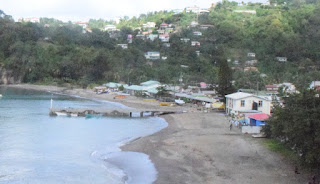Richard watched the ship come into St.
John's from the top deck.
Richard had booked a tour from Lawrence of Antigua. We met him on the dock, and learned that he has three vans. Lawrence was our tour guide. He has earned a good reputation, although he seemed a little bored, after 25 years in business.
We headed through the center of the
island, towards Nelson's Dockyard, a UNESCO world heritage site. We
stopped at Shirley Heights, which were part of the system of British
fortifications.
Nelson's dockyard itself is a natural
harbor, including an inner harbor. In 1784, Horatio Nelson was
assigned as second in command of the Leeward Islands Station, years
before he became famous at the Battle of Trafalgar. The dockyard is
the only Georgian-era dockyard still in use. The dockyard has been
restored, including the capstans that were used to careen (tilt) the
ships for maintenance. The dockyard is still in use for yachts, so
tourists and yacht people share the space.
We headed back on the southeastern
coast. Lawrence tried to tempt us with a pretty beach, but no one
was buying, so we went back to St. John's, and the ship.
Sandi and I went out walking in the
town of St. John's, including a stop at the Anglican Cathedral, which
was being repaired. There were numerous graves from the early
1700s. We also stopped at an internet cafe, where we checked our
email and called home. We found out from the neighbors that schools
in Boulder were closed, due to 18 inches of snow.
We tried out Richard's new GPS from the
top of the ship, and looked at the chart showing the ship's route
plan. We called it a night early.
On January 6th, we landed at
Castries, St. Lucia. Sandi was up early enough to watch the ship
arrive, and turn around in the harbor to point out. When we left
the ship, we had to go through a large shopping area owned by the
cruise line. Richard was not happy about their attempt to hold us
captive. Royal Caribbean clearly does not want us to go to town.
We walked to town through an industrial port area, and found a taxi
driver to take us to the Caribelle batik factory, which is far off
the beaten path. We watched a demonstration of the batik process,
and then Sandi did some shopping, including a bright blue tropical
shirt for Richard.
We continued down the coast, most
notably to the village of Anse-La-Raye, a colorful fishing village.
The area was very green, although the dry season had started. We also went through a large banana plantation, which we were told is a kind of a co-operative. The bananas are protected by blue plastic bags.
The roads were extremely twisty, and we were glad that we had decided not to drive all the way to the Pitons, twin peaks which are the symbol of St. Lucia. This is a volcanic island, and very mountainous.
Our general impression was that St.
Lucia was an ecotourism destination, and that it was more third world
than Antigua. They have a new prime minister, and the people are
eager for change, as the previous prime minister had not kept his
promises. The language is primarily Kweyol, a French based creole
language, although the official language is English. It was often a
challenge to understand our driver, through his thick accent. He
pointed out Massacre Hill, where slaves had been killed. He was very
proud of his country, and we enjoyed listening to him. We learned
that he had five children, and that he owned his taxi, which he
bought used from Japan. Apparently most cars are imported that way,
as they are much cheaper than new cars. Tourism is clearly the
primary industry.
We returned to the ship for a late
lunch.
We watched the ship depart from our
balcony. The excitement was when the man working the ship's lines,
tried to cast off the lines from the buoy, but the lines snagged or
jammed, so he had to go back and rearrange the lines. After the
second try, and a hard pull from the ship, the lines finally came off
the buoy.









No comments:
Post a Comment